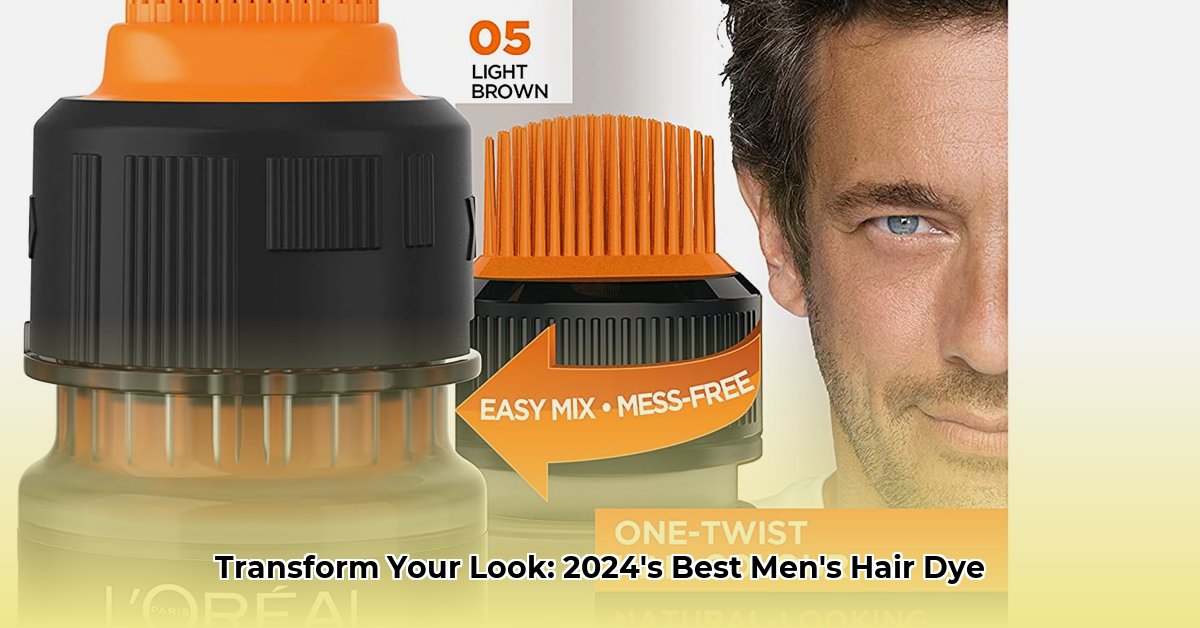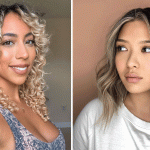Thinking about dyeing your hair? You’re not alone! More and more men are experimenting with color to enhance their style, cover grays, or simply try something new. This comprehensive guide provides everything you need to know to achieve the look you want safely and effectively. From subtle enhancements to bold transformations, the world of men’s hair color offers endless possibilities. For those with brown skin, check out these helpful tips.
Decoding Hair Dye: Types, Formulations, and Considerations for Men
Selecting the right hair dye is crucial for achieving your desired look and minimizing potential damage. Different types of dyes offer varying levels of commitment and impact on your hair’s health. Therefore, understanding the array of choices available is vital for making a well-informed decision that matches your preferences and lifestyle.
- Permanent Hair Dye: The most impactful option, permanently altering your hair color until it grows out. Ideal for complete gray coverage and dramatic transformations. However, it can be the harshest on your hair, potentially affecting texture and increasing the risk of allergic reactions. Permanent dyes penetrate the hair shaft to deposit color, offering long-lasting results but requiring more maintenance as roots grow out.
- Semi-Permanent Hair Dye: A balanced approach, gradually fading with each wash. Gentler than permanent dye, making it suitable for subtle color enhancements or experimenting with new shades without a long-term commitment. Semi-permanent dyes coat the hair shaft, providing color that lasts through several washes but eventually fades completely.
- Demi-Permanent Hair Dye: Similar to semi-permanent but contains a low-volume developer that allows some penetration into the hair shaft. This results in longer-lasting color compared to semi-permanent options, typically lasting up to 24 washes. Demi-permanent dyes are a good choice for blending gray or enhancing natural color without a significant commitment.
- Temporary Hair Dye (Sprays, Mousses, Gels): The easiest and least damaging option, washing out in one or two shampoos. Perfect for a temporary change or a fun event, but generally ineffective for complete gray coverage or dramatic color transformations. Temporary dyes simply coat the hair surface, providing instant color that rinses out easily.
- Root Touch-Up Kits: Designed for extending the life of your color between full dye jobs. These kits typically include a cream or spray that matches your existing hair color and covers new growth at the roots. Ideal for maintaining a consistent look without repeated full applications.
Consider your hair type and texture before choosing a dye. Thick, coarse hair may process color differently than fine, straight hair. Porosity, or the hair’s ability to absorb moisture, also affects color uptake. Dyes with moisturizing ingredients can help maintain hair health and prevent dryness.
Salon vs. At-Home Dyeing: Weighing the Pros and Cons
Deciding whether to dye your hair at home or visit a salon depends on your budget, experience, and desired results. Both options have their advantages and disadvantages: How much are you willing to pay for the expertise of a professional application versus the cost savings of doing it yourself?
At-Home Dyeing:
Pros:
- Cost-Effective: Significantly cheaper than salon services, saving you money on labor costs.
- Convenient: Allows you to dye your hair on your own schedule, without needing appointments.
- Privacy: Some men prefer the discretion of dyeing their hair in the privacy of their own homes.
Cons:
- DIY Application Challenges: Achieving even color distribution can be difficult, especially on your own.
- Potential for Mistakes: Inexperienced users may encounter uneven color, streaks, or unwanted tones.
- Product Selection Overload: Navigating the vast array of at-home dye products can be overwhelming.
Salon Dyeing:
Pros:
- Professional Results: Ensures even color coverage and expert application, minimizing the risk of errors.
- Expert Consultation: Provides access to stylists who can offer personalized color recommendations and assess hair health.
- Relaxing Experience: Can be a pampering and stress-free experience, allowing you to relax while a professional handles the process.
Cons:
- Higher Cost: Salon services can be significantly more expensive than at-home dyeing.
- Time Commitment: Requires scheduling an appointment and setting aside time for the service.
- Limited Control: You are relying on the stylist’s expertise, which may not always align with your vision.
The ideal choice hinges on your budget, comfort level, and desired level of perfection. If you’re unsure or aiming for a drastic change, consulting a professional is highly recommended.
Mastering At-Home Hair Dye Application: A Detailed Guide
Ready to try it yourself? Follow these steps for successful at-home hair dyeing. Thorough preparation is essential for achieving salon-quality results in your own bathroom.
- Prepare Your Workspace: Protect surfaces with newspapers, old towels, or a plastic sheet to prevent staining. Gather your dye kit, gloves, applicator brush, bowl (if needed for mixing), a mirror, and a timer. Ensure adequate lighting for clear visibility.
- Perform a Strand Test: Before applying dye to your entire head, test a small, hidden section of hair to assess color outcome and processing time. This helps prevent unexpected results.
- Conduct an Allergy Test: This is crucial! Apply a small amount of dye to a clean area of skin (behind your ear or on your inner arm) 48 hours before dyeing. Monitor for redness, itching, or irritation. Discontinue use if any adverse reaction occurs.
- Protect Your Skin and Clothing: Apply a thin layer of petroleum jelly or a barrier cream to your hairline, ears, and neck to prevent staining. Wear old clothing that you don’t mind getting stained.
- Follow Instructions Carefully: Each dye kit has unique instructions. Read them thoroughly and adhere to the recommended application method, processing time, and safety precautions.
- Mix Dye Components (If Necessary): Combine the dye and developer according to the instructions, ensuring a consistent mixture. Use a non-metallic bowl and applicator.
- Apply Dye Evenly: Start at the roots, where gray hair is most prominent or where the color needs the most saturation. Work your way through your hair in sections, ensuring every strand is coated evenly. Use a mirror to check the back of your head for complete coverage.
- Process for the Recommended Time: Set a timer for the exact processing time specified in the instructions. Under- or over-processing can affect your color results.
- Rinse Thoroughly: Rinse your hair with cool water until the water runs clear. This removes excess dye and helps seal the hair cuticle.
- Apply Conditioner: Use the conditioner included in the dye kit or a color-safe conditioner. Leave it on for a few minutes to nourish and hydrate your hair.
- Rinse Again: Rinse out the conditioner thoroughly.
- Dry and Style: Gently towel-dry your hair and style as usual. Avoid excessive heat styling immediately after dyeing.
Top Product Recommendations (and Precautions)
The hair dye market is crowded, but some products consistently receive high praise. Do note that these recommendations are based on general research and reviews, not endorsements. Always perform a strand test before full application.
- For Gray Coverage:
- Just For Men Original Formula: A classic choice known for its effective and quick gray coverage. However, some users find the color can appear too uniform.
- Grizzly Mountain Barber Shop Natural Beard Dye: Marketed for beards, but can also be used on hair for a natural-looking gray blend. Uses plant-based ingredients.
- For Bold Colors:
- Good Dye Young: Created by Hayley Williams of Paramore, this brand offers a range of vibrant, semi-permanent colors.
- Manic Panic: Another popular brand for bold colors, known for its wide selection and long-lasting results.
- For Sensitive Skin:
- Naturtint Permanent Hair Color: A gentle formula with plant-based ingredients and minimal chemicals.
- Herbatint Permanent Hair Color Gel: Another option with a focus on natural ingredients and low ammonia content.
Always read product reviews and consider your specific hair type and concerns before making a purchase.
| Product Category | Pros | Cons |
|---|---|---|
| Permanent Hair Dye | Long-lasting color, excellent gray coverage | Higher risk of allergic reactions, potential for hair damage, can look unnatural if not applied carefully |
| Semi-Permanent Hair Dye | Gentler on hair, gradually fades, good for experimenting with color | Shorter-lasting results, may not completely cover gray, limited color selection |
| Temporary Hair Dye (Sprays, etc.) | Easiest to use, washes out quickly, ideal for temporary color changes | Least effective for gray coverage, potential for staining, can transfer onto clothing |
| Demi-Permanent Hair Dye | Lasts longer than semi-permanent, good for blending gray, adds shine | Can’t lighten hair, limited color change |
| Root Touch-Up Kits | Convenient for maintaining color between full applications, easy to use | Only covers roots, may not perfectly match existing color |
Troubleshooting Common Hair Dye Issues
Even with careful application, problems can
- Wellness Fair Ideas for Work to Boost Employee Wellbeing - December 15, 2025
- Affordable Employee Wellness Fair Ideas for Any Budget - December 14, 2025
- Employee Wellness Programs Strategically Benefit Employee Health And Retention - December 13, 2025
















